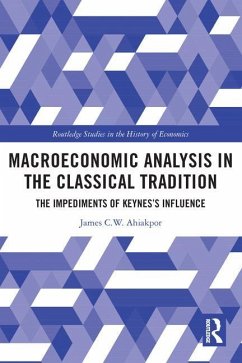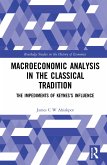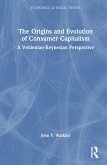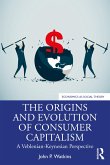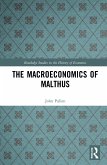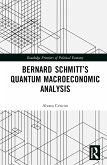James C W Ahiakpor
Macroeconomic Analysis in the Classical Tradition
The Impediments Of Keynes's Influence
James C W Ahiakpor
Macroeconomic Analysis in the Classical Tradition
The Impediments Of Keynes's Influence
- Broschiertes Buch
- Merkliste
- Auf die Merkliste
- Bewerten Bewerten
- Teilen
- Produkt teilen
- Produkterinnerung
- Produkterinnerung
Macroeconomic Analysis in the Classical Tradition explains how the influence of Keynesà â â s macroeconomics, including his changed definitions of some key macroeconomic concepts, has impeded many analystsà â â ability to readily resolve disputes in modern macroeconomics.
Andere Kunden interessierten sich auch für
![Macroeconomic Analysis in the Classical Tradition Macroeconomic Analysis in the Classical Tradition]() James C W AhiakporMacroeconomic Analysis in the Classical Tradition154,99 €
James C W AhiakporMacroeconomic Analysis in the Classical Tradition154,99 €![The Origins and Evolution of Consumer Capitalism The Origins and Evolution of Consumer Capitalism]() John P. WatkinsThe Origins and Evolution of Consumer Capitalism149,99 €
John P. WatkinsThe Origins and Evolution of Consumer Capitalism149,99 €![The Origins and Evolution of Consumer Capitalism The Origins and Evolution of Consumer Capitalism]() John P. WatkinsThe Origins and Evolution of Consumer Capitalism36,99 €
John P. WatkinsThe Origins and Evolution of Consumer Capitalism36,99 €![The Macroeconomics of Malthus The Macroeconomics of Malthus]() John PullenThe Macroeconomics of Malthus43,99 €
John PullenThe Macroeconomics of Malthus43,99 €![A History of Financial Crises A History of Financial Crises]() Cihan Bilginsoy (University of Utah, Salt Lake City, USA)A History of Financial Crises84,99 €
Cihan Bilginsoy (University of Utah, Salt Lake City, USA)A History of Financial Crises84,99 €![Bernard Schmitt's Quantum Macroeconomic Analysis Bernard Schmitt's Quantum Macroeconomic Analysis]() Alvaro Cencini (Switzerland Universita della Svizzana Italiana)Bernard Schmitt's Quantum Macroeconomic Analysis151,99 €
Alvaro Cencini (Switzerland Universita della Svizzana Italiana)Bernard Schmitt's Quantum Macroeconomic Analysis151,99 €![Financialization and the Future of the American Economy Financialization and the Future of the American Economy]() William K TabbFinancialization and the Future of the American Economy43,99 €
William K TabbFinancialization and the Future of the American Economy43,99 €-
-
-
Macroeconomic Analysis in the Classical Tradition explains how the influence of Keynesà â â s macroeconomics, including his changed definitions of some key macroeconomic concepts, has impeded many analystsà â â ability to readily resolve disputes in modern macroeconomics.
Produktdetails
- Produktdetails
- Routledge Studies in the History of Economics
- Verlag: Taylor & Francis Ltd
- Seitenzahl: 254
- Erscheinungstermin: 26. September 2022
- Englisch
- Abmessung: 234mm x 156mm x 14mm
- Gewicht: 400g
- ISBN-13: 9780367721930
- ISBN-10: 0367721937
- Artikelnr.: 65609127
- Herstellerkennzeichnung
- Libri GmbH
- Europaallee 1
- 36244 Bad Hersfeld
- gpsr@libri.de
- Routledge Studies in the History of Economics
- Verlag: Taylor & Francis Ltd
- Seitenzahl: 254
- Erscheinungstermin: 26. September 2022
- Englisch
- Abmessung: 234mm x 156mm x 14mm
- Gewicht: 400g
- ISBN-13: 9780367721930
- ISBN-10: 0367721937
- Artikelnr.: 65609127
- Herstellerkennzeichnung
- Libri GmbH
- Europaallee 1
- 36244 Bad Hersfeld
- gpsr@libri.de
James C. W. Ahiakpor is Emeritus Professor of Economics at California State University East Bay, Hayward, USA.
(1) Introduction: The Pervasive Impediment of Keynes's Influence in Modern
Macroeconomic Analysis (2) Interpreting Say's Law of Markets or Outlets
Correctly: The Impediments of Keynes's Influence (3) Could Keynes have
made a Legitimate Case against John Stuart Mill's Statement of the Law of
Markets? An Illustration of Keynes's Abiding Influence (4) Saving and the
Relevant Ricardian Equivalence Theorem (5) Milton Friedman's Permanent
Income Hypothesis: A Distraction from Keynes's Misrepresentation of Saving
as Non-spending (6) The Classical Heritage of Monetary Theory and Policy
at Chicago and Harvard before the Keynesian Conquest (7) 100% Money: A
Harmful Proposal Appropriately Ignored (8) Keynes's Liquidity Trap is
Impossible: Classical Monetary Analysis Helps to Explain (9) The Classical
Roots of the Phillips Curve Analysis (10) The Future of Keynesian
Economics: Struggling to Sustain a Dimming Light (11) Conclusion: Some
Policy Implications of Ridding Macroeconomics of Keynes's Influence
Macroeconomic Analysis (2) Interpreting Say's Law of Markets or Outlets
Correctly: The Impediments of Keynes's Influence (3) Could Keynes have
made a Legitimate Case against John Stuart Mill's Statement of the Law of
Markets? An Illustration of Keynes's Abiding Influence (4) Saving and the
Relevant Ricardian Equivalence Theorem (5) Milton Friedman's Permanent
Income Hypothesis: A Distraction from Keynes's Misrepresentation of Saving
as Non-spending (6) The Classical Heritage of Monetary Theory and Policy
at Chicago and Harvard before the Keynesian Conquest (7) 100% Money: A
Harmful Proposal Appropriately Ignored (8) Keynes's Liquidity Trap is
Impossible: Classical Monetary Analysis Helps to Explain (9) The Classical
Roots of the Phillips Curve Analysis (10) The Future of Keynesian
Economics: Struggling to Sustain a Dimming Light (11) Conclusion: Some
Policy Implications of Ridding Macroeconomics of Keynes's Influence
(1) Introduction: The Pervasive Impediment of Keynes's Influence in Modern Macroeconomic Analysis (2) Interpreting Say's Law of Markets or Outlets Correctly: The Impediments of Keynes's Influence (3) Could Keynes have made a Legitimate Case against John Stuart Mill's Statement of the Law of Markets? An Illustration of Keynes's Abiding Influence (4) Saving and the Relevant Ricardian Equivalence Theorem (5) Milton Friedman's Permanent Income Hypothesis: A Distraction from Keynes's Misrepresentation of Saving as Non-spending (6) The Classical Heritage of Monetary Theory and Policy at Chicago and Harvard before the Keynesian Conquest (7) 100% Money: A Harmful Proposal Appropriately Ignored (8) Keynes's Liquidity Trap is Impossible: Classical Monetary Analysis Helps to Explain (9) The Classical Roots of the Phillips Curve Analysis (10) The Future of Keynesian Economics: Struggling to Sustain a Dimming Light (11) Conclusion: Some Policy Implications of Ridding Macroeconomics of Keynes's Influence
(1) Introduction: The Pervasive Impediment of Keynes's Influence in Modern
Macroeconomic Analysis (2) Interpreting Say's Law of Markets or Outlets
Correctly: The Impediments of Keynes's Influence (3) Could Keynes have
made a Legitimate Case against John Stuart Mill's Statement of the Law of
Markets? An Illustration of Keynes's Abiding Influence (4) Saving and the
Relevant Ricardian Equivalence Theorem (5) Milton Friedman's Permanent
Income Hypothesis: A Distraction from Keynes's Misrepresentation of Saving
as Non-spending (6) The Classical Heritage of Monetary Theory and Policy
at Chicago and Harvard before the Keynesian Conquest (7) 100% Money: A
Harmful Proposal Appropriately Ignored (8) Keynes's Liquidity Trap is
Impossible: Classical Monetary Analysis Helps to Explain (9) The Classical
Roots of the Phillips Curve Analysis (10) The Future of Keynesian
Economics: Struggling to Sustain a Dimming Light (11) Conclusion: Some
Policy Implications of Ridding Macroeconomics of Keynes's Influence
Macroeconomic Analysis (2) Interpreting Say's Law of Markets or Outlets
Correctly: The Impediments of Keynes's Influence (3) Could Keynes have
made a Legitimate Case against John Stuart Mill's Statement of the Law of
Markets? An Illustration of Keynes's Abiding Influence (4) Saving and the
Relevant Ricardian Equivalence Theorem (5) Milton Friedman's Permanent
Income Hypothesis: A Distraction from Keynes's Misrepresentation of Saving
as Non-spending (6) The Classical Heritage of Monetary Theory and Policy
at Chicago and Harvard before the Keynesian Conquest (7) 100% Money: A
Harmful Proposal Appropriately Ignored (8) Keynes's Liquidity Trap is
Impossible: Classical Monetary Analysis Helps to Explain (9) The Classical
Roots of the Phillips Curve Analysis (10) The Future of Keynesian
Economics: Struggling to Sustain a Dimming Light (11) Conclusion: Some
Policy Implications of Ridding Macroeconomics of Keynes's Influence
(1) Introduction: The Pervasive Impediment of Keynes's Influence in Modern Macroeconomic Analysis (2) Interpreting Say's Law of Markets or Outlets Correctly: The Impediments of Keynes's Influence (3) Could Keynes have made a Legitimate Case against John Stuart Mill's Statement of the Law of Markets? An Illustration of Keynes's Abiding Influence (4) Saving and the Relevant Ricardian Equivalence Theorem (5) Milton Friedman's Permanent Income Hypothesis: A Distraction from Keynes's Misrepresentation of Saving as Non-spending (6) The Classical Heritage of Monetary Theory and Policy at Chicago and Harvard before the Keynesian Conquest (7) 100% Money: A Harmful Proposal Appropriately Ignored (8) Keynes's Liquidity Trap is Impossible: Classical Monetary Analysis Helps to Explain (9) The Classical Roots of the Phillips Curve Analysis (10) The Future of Keynesian Economics: Struggling to Sustain a Dimming Light (11) Conclusion: Some Policy Implications of Ridding Macroeconomics of Keynes's Influence

